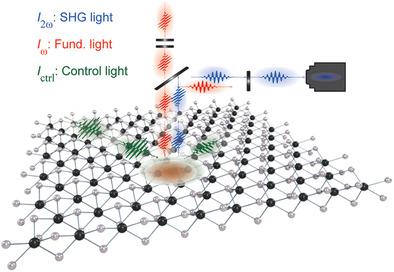Our official English website, www.x-mol.net, welcomes your feedback! (Note: you will need to create a separate account there.)
Photocarrier-Induced Active Control of Second-Order Optical Nonlinearity in Monolayer MoS2.
Small ( IF 13.3 ) Pub Date : 2020-01-14 , DOI: 10.1002/smll.201906347 Mohammad Taghinejad 1 , Zihao Xu 2 , Hua Wang 3 , Hossein Taghinejad 1 , Kyu-Tae Lee 1 , Sean P Rodrigues 1, 4 , Ali Adibi 1 , Xiaofeng Qian 3 , Tianquan Lian 2 , Wenshan Cai 1, 5
Small ( IF 13.3 ) Pub Date : 2020-01-14 , DOI: 10.1002/smll.201906347 Mohammad Taghinejad 1 , Zihao Xu 2 , Hua Wang 3 , Hossein Taghinejad 1 , Kyu-Tae Lee 1 , Sean P Rodrigues 1, 4 , Ali Adibi 1 , Xiaofeng Qian 3 , Tianquan Lian 2 , Wenshan Cai 1, 5
Affiliation

|
Atomically thin transition metal dichalcogenides (TMDs) in their excited states can serve as exceptionally small building blocks for active optical platforms. In this scheme, optical excitation provides a practical approach to control light-TMD interactions via the photocarrier generation, in an ultrafast manner. Here, it is demonstrated that via a controlled generation of photocarriers the second-harmonic generation (SHG) from a monolayer MoS2 crystal can be substantially modulated up to ≈55% within a timeframe of ≈250 fs, a set of performance characteristics that showcases the promise of low-dimensional materials for all-optical nonlinear data processing. The combined experimental and theoretical study suggests that the large SHG modulation stems from the correlation between the second-order dielectric susceptibility χ(2) and the density of photoexcited carriers in MoS2 . Indeed, the depopulation of the conduction band electrons, at the vicinity of the high-symmetry K/K' points of MoS2 , suppresses the contribution of interband electronic transitions in the effective χ(2) of the monolayer crystal, enabling the all-optical modulation of the SHG signal. The strong dependence of the second-order optical response on the density of photocarriers reveals the promise of time-resolved nonlinear characterization as an alternative route to monitoring carrier dynamics in excited states of TMDs.
中文翻译:

单层MoS2中光子诱导的二阶光学非线性主动控制。
原子态的过渡金属二卤化二硫醚(TMD)处于激发态,可以用作有源光学平台的极小构件。在此方案中,光激发提供了一种实用的方法,可以以超快的方式通过光生载流子来控制光-TMD相互作用。在此证明,通过控制光载流子的产生,单层MoS2晶体的第二谐波产生(SHG)可以在大约250 fs的时间范围内被调制至大约55%,这是一组表现出低维材料用于全光学非线性数据处理的前景。结合实验和理论研究表明,较大的SHG调制源于MoS2中二阶电介质磁化率χ(2)与光激发载流子密度之间的相关性。的确,在MoS2的高对称K / K'点附近,导带电子的减少抑制了单层晶体有效χ(2)中带间电子跃迁的贡献,从而实现了全光学SHG信号的调制。二阶光学响应对光电载流子密度的强烈依赖性揭示了时间分辨的非线性表征的希望,这是监视TMDs激发态中载流子动力学的替代途径。在MoS2的高对称K / K'点附近,抑制了单层晶体有效χ(2)中带间电子跃迁的贡献,从而实现了SHG信号的全光调制。二阶光学响应对光电载流子密度的强烈依赖性揭示了时间分辨的非线性表征的希望,这是监视TMDs激发态中载流子动力学的替代途径。在MoS2的高对称K / K'点附近,抑制了单层晶体有效χ(2)中带间电子跃迁的贡献,从而实现了SHG信号的全光调制。二阶光学响应对光电载流子密度的强烈依赖性揭示了时间分辨的非线性表征的希望,这是监视TMDs激发态中载流子动力学的替代途径。
更新日期:2020-02-07
中文翻译:

单层MoS2中光子诱导的二阶光学非线性主动控制。
原子态的过渡金属二卤化二硫醚(TMD)处于激发态,可以用作有源光学平台的极小构件。在此方案中,光激发提供了一种实用的方法,可以以超快的方式通过光生载流子来控制光-TMD相互作用。在此证明,通过控制光载流子的产生,单层MoS2晶体的第二谐波产生(SHG)可以在大约250 fs的时间范围内被调制至大约55%,这是一组表现出低维材料用于全光学非线性数据处理的前景。结合实验和理论研究表明,较大的SHG调制源于MoS2中二阶电介质磁化率χ(2)与光激发载流子密度之间的相关性。的确,在MoS2的高对称K / K'点附近,导带电子的减少抑制了单层晶体有效χ(2)中带间电子跃迁的贡献,从而实现了全光学SHG信号的调制。二阶光学响应对光电载流子密度的强烈依赖性揭示了时间分辨的非线性表征的希望,这是监视TMDs激发态中载流子动力学的替代途径。在MoS2的高对称K / K'点附近,抑制了单层晶体有效χ(2)中带间电子跃迁的贡献,从而实现了SHG信号的全光调制。二阶光学响应对光电载流子密度的强烈依赖性揭示了时间分辨的非线性表征的希望,这是监视TMDs激发态中载流子动力学的替代途径。在MoS2的高对称K / K'点附近,抑制了单层晶体有效χ(2)中带间电子跃迁的贡献,从而实现了SHG信号的全光调制。二阶光学响应对光电载流子密度的强烈依赖性揭示了时间分辨的非线性表征的希望,这是监视TMDs激发态中载流子动力学的替代途径。



























 京公网安备 11010802027423号
京公网安备 11010802027423号